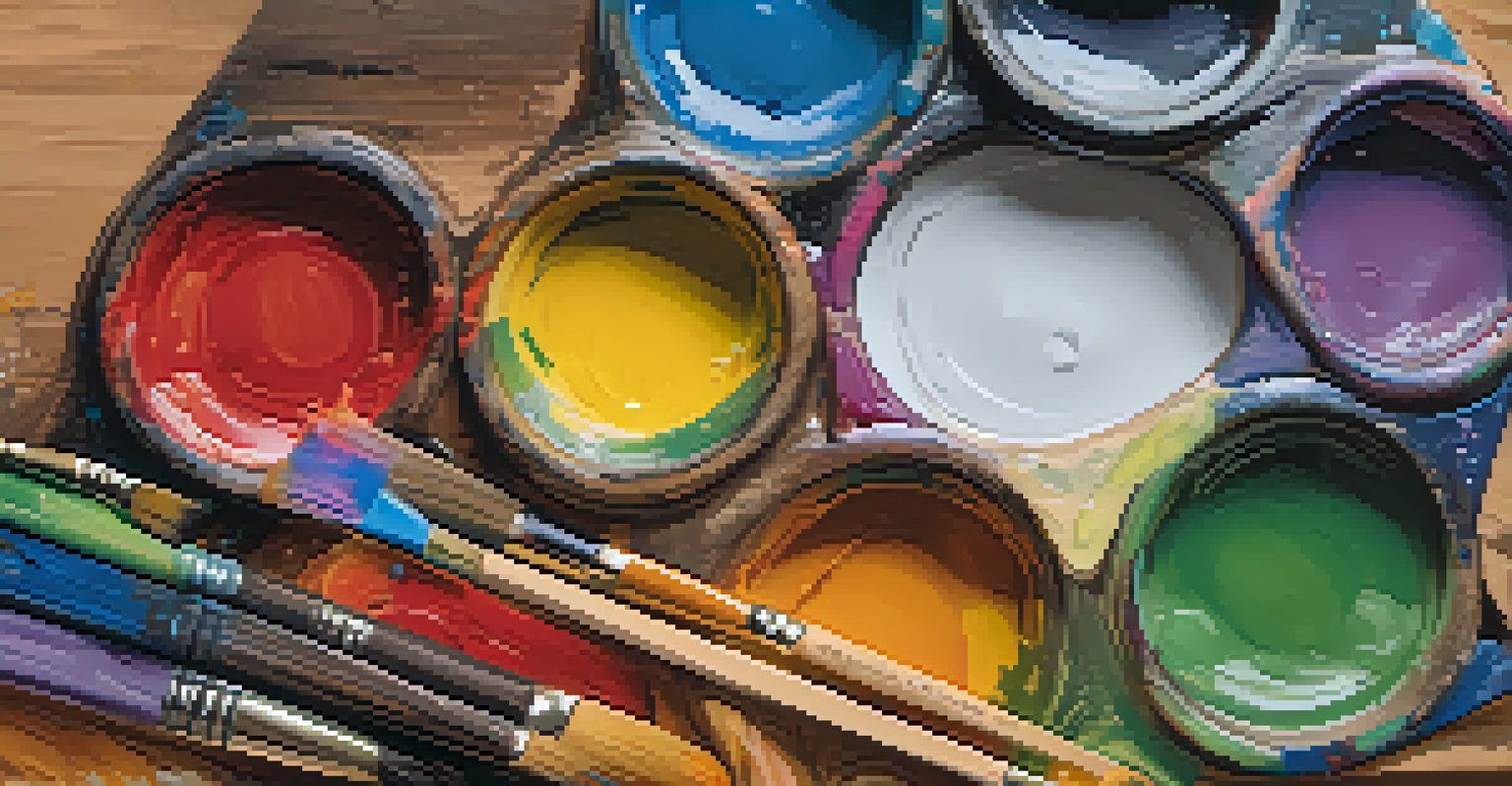Color Theory in Painting: Philosophical Implications of Colors

Understanding the Basics of Color Theory in Art
Color theory is a fundamental concept in painting that explores how colors interact with one another. It involves understanding the color wheel, which includes primary, secondary, and tertiary colors. This framework helps artists mix colors and create harmonious compositions, enabling them to evoke specific emotions or atmospheres in their work.
Color is the keyboard, the eyes are the harmonies, the soul is the piano with many strings.
At its core, color theory is not just about aesthetics; it also delves into the psychological effects colors can have on viewers. For instance, warm colors like red and yellow often evoke feelings of warmth and excitement, while cool colors such as blue and green may bring about calmness and serenity. This emotional response is a crucial part of how artists communicate their ideas.
By mastering color theory, painters can choose colors intentionally to convey deeper meanings and messages within their artwork. This understanding can lead to richer, more engaging pieces that resonate with audiences on multiple levels.
The Symbolism of Colors in Artistic Expression
Colors carry significant symbolic meanings that can vary across cultures and contexts, and artists often leverage this symbolism in their work. For example, white is frequently associated with purity and peace, while black may symbolize mourning or mystery. Such associations can add layers of meaning to a painting, inviting viewers to interpret the artwork on a deeper level.

Consider the use of red in many cultures; it can symbolize love, passion, or even danger. An artist who incorporates red into their painting might be deliberately tapping into these associations, guiding the viewer's emotional response. This kind of intentional color choice enriches the narrative and themes present in the artwork.
Color Theory Enhances Artistic Depth
Understanding color theory allows artists to create more meaningful and emotionally resonant artwork.
By understanding color symbolism, artists can create more nuanced and thought-provoking pieces. This interplay between color and meaning not only engages viewers but also encourages them to reflect on their personal experiences and emotions related to the colors depicted.
Philosophical Theories Surrounding Color Perception
Color perception is a fascinating topic that extends beyond art into the realms of philosophy and psychology. Philosophers have long debated whether colors exist independently or are merely perceptions created by our minds. This question prompts discussions about the nature of reality and how we interpret the world around us.
Colors, like features, follow the changes of the emotions.
For instance, the philosopher Johann Wolfgang von Goethe proposed that colors have emotional qualities and can influence human behavior. His perspective invites artists to consider how their use of color might affect viewers' feelings and actions. This philosophical approach can lead to a more conscious and reflective practice in painting.
Understanding these philosophical theories can help artists think critically about their color choices. It encourages them to explore not just how colors look, but also how they feel and what they signify, ultimately deepening the connection between the artwork and its audience.
Historical Context of Color in Artistic Movements
Throughout history, different art movements have embraced unique approaches to color, reflecting the cultural and philosophical ideas of their time. For instance, Impressionists like Claude Monet used vibrant colors to capture the fleeting effects of light, emphasizing the beauty of the moment. This marked a shift from the more muted palettes of earlier periods, showcasing a new appreciation for color in art.
Similarly, the Fauvist movement, led by artists like Henri Matisse, pushed the boundaries of color use even further. These artists used bold, non-representational colors to express emotion rather than realism, challenging traditional notions of how color should be applied in painting. Their work demonstrates how color can serve as a vehicle for personal expression and philosophical exploration.
Colors Carry Cultural Symbolism
Artists can leverage the symbolic meanings of colors to add layers of interpretation to their pieces.
By examining these historical contexts, we gain insight into how artists have utilized color as a means of expression throughout the ages. This understanding allows contemporary artists to draw inspiration from the past while also forging their own paths in the realm of color theory.
The Role of Light in Color Perception and Painting
Light plays a crucial role in how we perceive color, affecting everything from the brightness to the vibrancy of hues. In painting, artists must consider the light source and its quality when choosing colors, as natural and artificial light can dramatically alter how colors appear. This understanding can lead to more realistic and dynamic compositions.
For example, a sunset scene may require warm oranges and reds that glow under the fading light, while a midday landscape might benefit from cooler, more subdued tones. By manipulating light and color, artists can create depth, mood, and atmosphere, enhancing the viewer's experience.
Moreover, the interplay between light and color invites philosophical contemplation about perception and reality. It raises questions about how much of what we see is influenced by external factors and how much is shaped by our individual experiences and emotions.
Using Color to Convey Emotion and Narrative
Artists often use color deliberately to convey emotions and tell stories within their paintings. For instance, a somber scene might be rendered in dark, muted colors to evoke feelings of sadness or introspection, while a lively celebration could burst with bright, vibrant hues to reflect joy and energy. This intentional use of color can create a powerful connection between the artwork and the viewer.
Moreover, the emotional impact of color can vary based on cultural contexts and personal experiences. An artist who understands these nuances can craft narratives that resonate deeply with their audience. This ability to tap into shared emotions through color enhances the storytelling aspect of their work.
Light Influences Color Perception
The quality of light affects how colors are perceived, making it crucial for artists to consider lighting in their work.
Ultimately, color becomes a language of its own, allowing artists to communicate complex ideas and emotions without words. This highlights the importance of color theory not just as a technical skill, but as a vital component of artistic expression.
Conclusion: The Lasting Impact of Color Theory on Art
In conclusion, color theory is an essential aspect of painting that encompasses both technical skills and philosophical explorations. It empowers artists to use color not just for aesthetic appeal, but as a means of deeper communication and expression. Through understanding the emotional, symbolic, and perceptual aspects of color, artists can create work that resonates profoundly with viewers.
The historical context of color in art movements reveals how artists have continually pushed the boundaries of color use, adapting their techniques to reflect changing philosophies and cultural values. This ongoing evolution demonstrates the dynamic relationship between color theory and artistic practice.

As we continue to explore the philosophical implications of colors in painting, we are reminded of the profound impact color can have on our emotions, perceptions, and connections to art. Ultimately, color theory enriches both the creation and appreciation of art, inviting us to experience the world in new and vibrant ways.